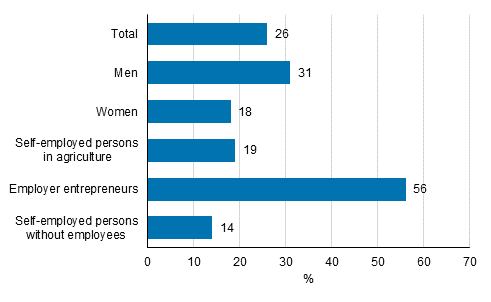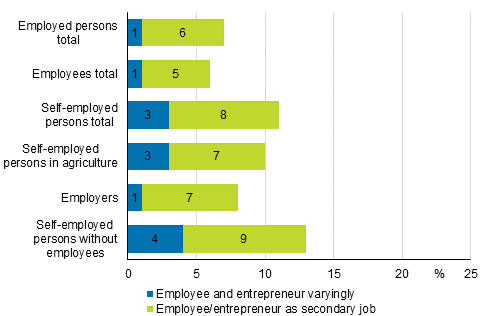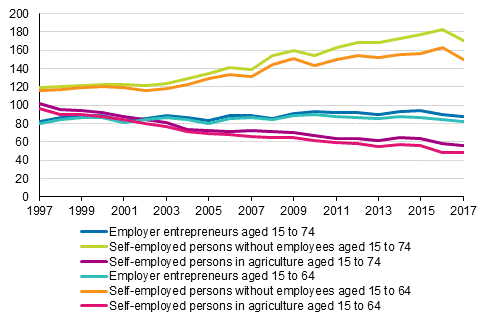News 21 Dec 2018
Self-employed persons in Finland favour subcontractors
Around one quarter of self-employed persons said in 2017 that they were planning to hire one or more employees in the next 12 months or so. Of the employer entrepreneurs, over one-half planned to hire additional labour force, but 14 per cent of self-employed persons without employees also considered hiring their first employee. Around one-fifth of self-employed persons in agriculture had considered hiring. Among self-employed men the plans to hire were more common than among women.
Has planned on hiring one or more employees during the next 12 months, self-employed persons by gender and type of self-employed person, %

When the workload in an enterprise grows, self-employed persons more often plan to use subcontractors than to hire employees. Of the self-employed persons active in Finland, 44 per cent used subcontractors in 2017 and even more planned to use subcontractors in the future.
The majority, or 70 per cent of self-employed persons active in Finland also said they convey orders to one another, share work or develop joint projects with other self-employed persons. This kind of network-like activity was slightly more common among men than among women.
“In Eurostat’s comparison, network-like working seems to be particularly common for self-employed persons active in Finland, after Norway and Iceland”, says Senior Researcher Anna Pärnänen from Statistics Finland.
Self-employed persons without hired employees had several reasons for not planning to hire labour force in the near future either. The most common reasons were the desire to employ primarily oneself and too high indirect employee costs when hiring. The reason was also that customers wanted a self-employed person to do the job, insufficient amount of work and a desire to rather work with sub-contractors or business partners.
Around 1 per cent of the employed have combined work
In Statistics Finland’s Labour Force Survey, a person’s occupational status is determined based on the work done in the survey week. If there are several different jobs or work places, the one where most working hours were done is usually selected as the main job.
Of all employed persons, around one per cent, or around 30,000 persons, had worked as both an employee and an entrepreneur so varyingly during the last 12 months that they could not name either form of working as their main occupational status. However, these persons have been classified as either only employees or entrepreneurs in the labour force statistics. The situation is called combined work here.
“The group of persons doing combined work is small, but especially challenging from the viewpoint of social security legislation”, says Senior Researcher Hanna Sutela from Statistics Finland.
Especially young people aged under 35 do combined work, but there was hardly any difference between genders.
Combination of paid work and entrepreneurial work in the last 12 months, share of employed persons, employees and self-employed persons, %

In addition to this kind of actual combined work, around eight per cent of self-employed persons had also done paid work, and around five per cent of employees had also done entrepreneurial work in the past 12 months. The share of these persons, who beside their main job had a secondary job with another occupational status of all employed persons, was around six per cent, or around 140,000 persons.
Clear changes in the structure of self-employed persons
The number of self-employed persons in Finland has remained quite stable during the last couple of decades. However, during this time there has been a clear change in the structure of self-employed persons.
The number and share of self-employed persons in agriculture of all self-employed persons has continuously decreased. The number and share of so-called self-employed persons without employees, that is, persons working as sole entrepreneurs or like entrepreneurs, own-account workers, freelancers and grant recipients has increased correspondingly. There has not been much change in the number of employer entrepreneurs.
Women's share of all self-employed persons is around one-third and the share has not changed during the last couple of decades. Employer entrepreneurs and self-employed persons in agriculture are especially male-dominated groups, while the gender structure is slightly more even among self-employed persons without employees.
Self-employed persons in agriculture, employer entrepreneurs and self-employed persons without employees in Finland in 1997 to 2017, aged 15 to 64 and 15 to 74, 1,000 persons

First comprehensive survey on self-employed persons
The report published by Statistics Finland on Self-employed persons in Finland 2017 is based on a large interview survey, which for the first time studies the situation of different types of self-employed persons with an interview survey based on the population.
The survey consists of two separate parts: the ad-hoc module of the Labour Force Survey concerning self-employed persons conducted in the same way in all EU countries and the national part carried out by Statistics Finland. The report examines issues related to the work situation, working conditions, growth prospects, networking and livelihood as well as social security among self-employed persons.
The survey was financed by the Ministry of Economic Affairs and Employment, the Finnish Innovation Fund Sitra, the Finnish Centre for Pensions, the Finnish Institute of Occupational Health and Statistics Finland.
Source: Self-employed persons in Finland 2017. Statistics Finland.
Further information: Senior Researcher Anna Pärnänen +358 29 552 3795, Senior Researcher Hanna Sutela +358 29 551 2907
